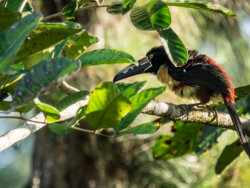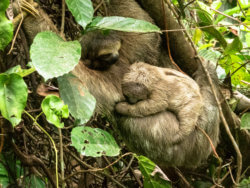Luna Nueva in February – it’s a glorious time to visit. The rains of early January have given way to bright skies and cool nights, and photographers can luxuriate in the early morning sunlight. We thought to take you on a stroll of the farm, perhaps inspiring you to come visit – or come back!
More than half of our land is protected primary rainforest, and a family of howler monkeys was making itself heard. We followed the howls and there, in a tree about 40 meters down a hillside, we found this family of howlers.

You can just spy the baby peeking back toward us, as the papa howled his disapproval that we were so near. Not far from this family unit we saw a juvenile up in a nearby tree –

From the howlers to the hummers

There are approximately 50 known species of hummingbirds in Costa Rica, and our fields and forests are home to many of them. We are a regenerative ecolodge, and the rules that govern us say we may not put out food to attract birds. We are allowed, of course, to plant flowers that delight the hummers and all manners of birds, which we’ve done around the farm. An added benefit is that those flowers also delight our guests!
One of our favorite bird residents is the araçari toucan.

One morning between 20 to 30 of these colorful toucans – an avalance of araçaris! – came to trees in front of one of the lodgings. They stayed for about 10 minutes, only to be chased away by a flock of oropendolas.

These golden-tailed members of the oriole family are crowd pleasers. They construct curious nests that look like pendant earrings, and you can sometimes find a tree with dozens of these pendant nests. One loud male presides over that colony, and our guests often hear the various calls of this bird, ranging from scratchy crackles to something you’d think was made by the robot R2D2. The louder calls are accompanied by what can be described, in baseball terms, as the wind up and the pitch. The birds hang their bodies straight down and then hurl themselves upright, emitting with that motion a synthesized sound that simply cannot be. But it is, and you’ll hear it often at the farm.
Babies were happening this month. While walking on our Cabalonga Trail, Carlos Arias heard a mama puma and her babies. Several of our guests saw the mama puma on that trail, and now it seems we have a growing family of these majestic cats. We also were surprised that a young sloth became a mother. We didn’t think she was old enough, but Mother Nature had a different idea.

We believe that the mama sloth in the above photo was the baby sloth in this earlier photo:

Nothing is guaranteed in the rainforest, but our guests are very likely to see three-toed sloths at Luna Nueva. And sometimes even the larger two-toed sloths, but those are less frequently seen.
And did you ask about butterflies and breadnuts? We got ’em! We often see but can never photograph the blue morpho butterfly. They are magical, the unicorns of our rainforest, but they’ve defied our attempts to photograph their blue luminence. Not lesser, just different, is this other little blue creature we saw this month

And we have many mature breadnut trees, known locally as castaña and scientifically as Autocarpus camansi.

This tree produces one of the seeds called breadnuts and there are many ways to prepare this delicious food. This tree is an important part of our “regenerative agriculture” mission, as it fits into permaculture design and delivers large amounts of nutritious food while sequestering carbon dioxide and rebuilding soil.
We’ll end this stroll through the month of February with two of our favorites plants. The first is one of our native stinging nettles.

Stinging nettles have cultural, medicinal, and culinary significance. We have made a vegetarian rennet from stinging nettle for cheese production, the plant produces both a histaminic and anti-histaminic reaction, and we have heard from an indigenous representative that several of the native nettles are used medicinally. For us, the nettle takes on another major role as part of our biodynamic practices. We are a Demeter-certified biodynamic farm, and to Rudolf Steiner there was nothing more fundamental than stinging nettle.
And last we leave you with the jade vine. It’s a perfect final statement….

We hope to see you here some future February.
Pura Vida!

